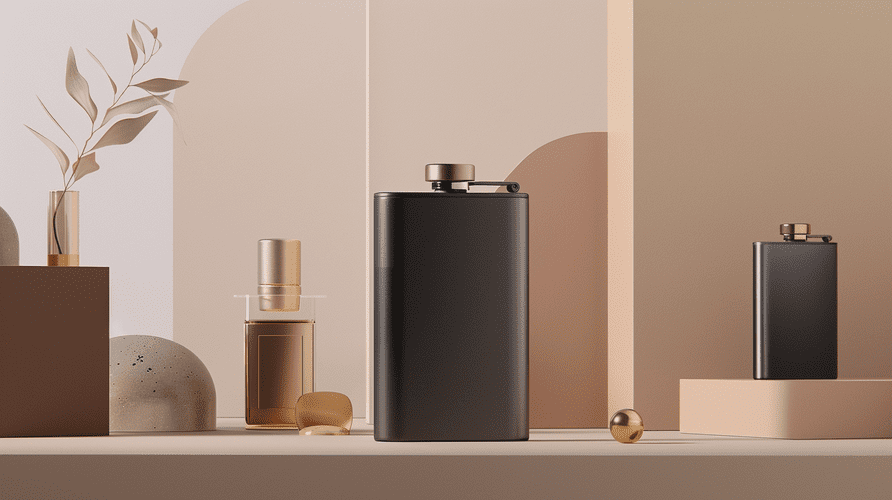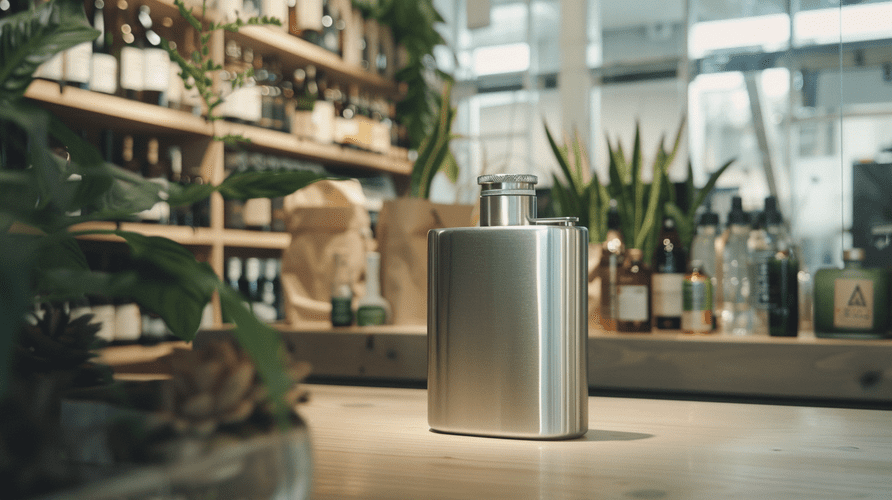Struggling to keep your hip flask offerings current? Market demands are evolving quickly. Let me guide you through what B2B buyers need to anticipate for the coming year.
For 2025, the main trends in stainless steel hip flasks are all about ensuring safety with food-grade materials like 304 steel. They also highlight their continued appeal in niche markets such as gifting and outdoor activities. Crucially, educating users on proper care and suitable beverages is key.

Understanding these trends is a good first step. As someone in procurement or a business owner yourself, you want to source products that your customers will love. You also want to address their questions before they even ask. So, let's look at some common concerns and how we can address them.
Are Stainless Steel Hip Flasks Safe?
Are your customers worried about harmful materials in their flasks? These safety fears can stop a sale cold. Let me show you why high-quality stainless steel is so important.
Yes, good stainless steel hip flasks are safe. This is especially true if they are made from food-grade 304 stainless steel1. This type of steel does not react with liquids. So, it won't release harmful chemicals or change the taste of the spirits inside.

When B2B buyers, like my client Mark Shenng from Canada, ask about safety, I know it's a top concern. Mark sources stainless steel water bottles and hip flasks for his distribution business. He needs to assure his customers of premium quality. The safety of the material is paramount.
Why Food-Grade Steel Matters
Food-grade stainless steel, often type 304 (also known as 18/8 because it has 18% chromium and 8% nickel), is the best choice for hip flasks. The chromium helps it resist rust. The nickel makes it strong. This mix means the steel won't react with alcohol, even strong spirits. So, there's no metallic taste. More importantly, no harmful stuff gets into the drink. When I talk to procurement officers, I always say: check the steel grade. It’s the first sign of a quality, safe flask. We at Icobottle make sure our flasks meet this standard, often providing material certifications to clients like Mark. This transparency was key when he was deciding to purchase from us in China.
What to Avoid
Some cheaper flasks might use lower-grade stainless steel. They might even use other metals that are not as safe. For example, old pewter flasks sometimes had lead, which is very harmful. This is not common now, but it shows why material choice is vital. Also, be careful with flasks that have plastic liners. Make sure the plastic is food-safe and BPA-free2. Some plastics can leach chemicals.
The Role of Certifications
For B2B buyers, certifications give you peace of mind. Look for suppliers who can show FDA (U.S. Food and Drug Administration) or LFGB (German Food and Commodities Act) compliance. These papers mean the product was tested and meets strict safety rules for things that touch food. We at Icobottle take this very seriously. All our products, from hip flasks to water bottles, meet these international standards. This ensures that when you wholesale from us, you're getting top-quality, safe products.
Do People Still Use Hip Flasks?
Do you think hip flasks are becoming old-fashioned? Worried about investing in a market that's shrinking? You might be surprised by how popular they still are today.
Yes, people definitely still use hip flasks. They might not carry them every day like they used to. But hip flasks are very popular for certain times. Think outdoor activities, weddings, thoughtful gifts, and as cool personal items for special events.

The way people use hip flasks has changed a bit, but the demand is steady. As a manufacturer and exporter to America and Europe, I've seen this firsthand. It's less about secretly sipping and more about having a personal, quality accessory.
The Evolving Role of the Hip Flask
The old idea of someone always taking sips from a hip flask isn't really today's reality. But the hip flask has found its place. It's now about convenience, style, or sharing a moment. I see this when I talk to clients. They are not just looking for a container. They want an accessory that means something or is useful for a specific activity. For example, many startup bosses look for unique, customizable items for their brand promotion, and hip flasks fit that need perfectly.
Key Niche Markets
Demand is strong in several areas:
- Gifting: This is a big one. Engraved hip flasks are popular for groomsmen gifts, big birthdays, and even company gifts. At Icobottle, we get many requests for custom logos and messages. Our ability to offer top-quality customization on colors and logos makes these items very attractive.
- Outdoor Activities: For people who hike, camp, or fish, a hip flask is a handy way to carry a warm drink. It's much easier than carrying a full bottle.
- Special Events: Think concerts, festivals, or a day at the races. It’s about having your favorite drink ready.
- Personal Accessory: For some, a nice hip flask is a style choice, like a good watch or pen. It shows personality.
Customization Drives Appeal
One big reason they stay popular is customization. We can do laser engraving, different color coatings, and unique shapes. This lets businesses offer personal products that people really like. This is where B2B buyers can give their customers something special. It's not just a flask; it's their flask.
What Should You Not Put in a Hip Flask?
Are you putting the wrong kind of drink in a hip flask? This can spoil the flask and your drink. It's important to know which liquids are safe and which are not.
You should avoid putting acidic drinks like fruit juices (lemon or orange) in a flask. Also, stay away from fizzy drinks or creamy liqueurs. These can react with the metal over time. Or they can spoil quickly. This affects the taste and can even damage the flask.

It's a common question I get, especially from new clients or those looking to educate their own customers. Ensuring the end-user has a good experience is vital for repeat business.
Stick to Spirits
Stainless steel hip flasks are made for neat spirits. This means drinks like whiskey, bourbon, scotch, rum, gin, vodka, or brandy. These drinks have a high alcohol content. They are stable and won't react badly with good quality stainless steel in the short term. This is what flasks are built for. It’s what your customers should mainly use them for. When I provide products to clients like Mark in Canada, who rebrands them for a premium market, ensuring this basic knowledge is passed on is crucial.
Liquids to Avoid
Telling your customers about this is important for their happiness:
- Acidic Mixers and Juices: Drinks like fruit juice (especially citrus like lemon or orange), wine, or cocktails with these things should not be stored for long. The acid can, over time, react with the steel. This might cause a metallic taste or even a little bit of rust. This is less of a problem with high-grade 304 steel, but it's still best to avoid it. I once had a customer contact me because his drink tasted metallic. It turned out he was keeping a vodka and orange juice mix in his flask for several days. The orange juice was the problem.
- Creamy Liqueurs: Drinks like Baileys or other dairy-based liqueurs are a big no. They can spoil very fast, even in the fridge. They are also very hard to clean out completely. This can leave bad smells and bacteria.
- Carbonated Drinks: Sodas, sparkling wine, or beer should not go into a normal hip flask. The fizz can build up pressure. This could damage the flask or make it leak.
- Energy Drinks: Many energy drinks are also quite acidic. Some are fizzy too. So, they are also on the "avoid" list.
Including a small care guide, as Mark does with his products in Canada, can prevent many issues.
How Long Can You Keep Alcohol in a Stainless Steel Flask?
Are you storing alcohol in your flask for too long? The taste can change, and the quality of the spirit might go down. It's good to know the best storage time.
For the best taste, you should only keep alcohol in a stainless steel flask3 for a few days. A week at most is usually okay. Flasks are for carrying drinks easily, not for storing them long-term. Long contact can subtly change the flavor.

This is a key piece of advice I always give to my B2B customers. They need to manage the expectations of their end-users. A hip flask is for convenience and style, not for aging spirits.
Portability, Not Preservation
The first thing to know is that a hip flask is for carrying spirits easily for a short time. It's not for long-term storage like a glass bottle. Good stainless steel doesn't react much. But the main goal is to keep the original taste of the spirit. My company, Icobottle, focuses on top-quality stainless steel, but even then, flasks are not meant to be mini-cellars.
Recommended Timeframe
Most experts would say this:
- Optimal: Drink the contents within 1 to 3 days. This makes sure the spirit tastes just as it should.
- Acceptable: You can probably keep spirits in a flask for up to a week. This should be fine, especially if it's a quality flask and a strong spirit like whiskey.
If you leave it longer than a week, the alcohol itself won't "go bad" (it has too much alcohol for that). But there's a small chance the flavor might change a tiny bit. Or a slight metallic taste could appear. This is more likely if the flask isn't made of the best 304 stainless steel.
Why Not Longer?
It's not usually about spirits spoiling. It's more about keeping the flavor just right. The original company bottled it in glass for a reason. Glass is the best material for storing alcohol for a long time because it doesn't react at all. A flask is great for a weekend trip or a night out. But it's not a replacement for the original bottle if you want to keep it for months. I always tell my clients, like Mark, to advise their end-users: treat your flask like a good glass, not a long-term decanter. Rinse it after you've finished its contents. A quick rinse with warm water is usually enough. For a deeper clean, a bit of vinegar and water, or special cleaning tablets, work well. Proper cleaning is key to keeping the flask good and making sure every sip tastes right.
Conclusion
For 2025, successful B2B hip flask sales depend on offering safe, quality products. Understand how people use them and guide them on care. This builds trust and makes customers happy.
-
Understanding food-grade 304 stainless steel is crucial for ensuring safety in products like hip flasks. Explore this link for detailed insights. ↩
-
BPA-free materials are vital for health safety. Discover why choosing BPA-free products is essential for your well-being. ↩
-
Explore this link to learn effective cleaning methods for your stainless steel flask, ensuring optimal taste and longevity of your spirits. ↩

